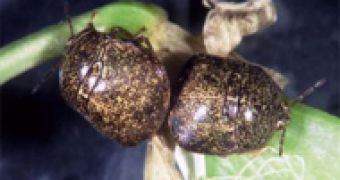We, humans, use aphrodisiacs to enhance fertility.
There are various recipes and food recommended for a better sexual life.
But sometimes nature can offer even germs to do this job. The plataspid stinkbug (Megacopta punctatissima) is a severe pest on soybean crops, and often leads to entire fields wasted. They have a formidable breeding power, and now researchers at University of Tokyo have uncovered their secret aphrodisiac: gut bacteria, allowing the insect to invade the fields.
Without the microbe, the stinkbug's population plummets to harmless effectives.
The research team cleaned out a lab population of punctatissima and then put the bacteria into the gut of a related stinkbug, M. cribraria, which does not normally produce invasion on soy crops, even if they do feed on soy. The result of the experiment: suddenly, M. punctatissima's egg hatching dropped in sterile (no germs) lab conditions, whereas M. cribraria's boomed.
This explains more on insect evolution, but it could also lead to the development of new more environmentally friendly pesticides.
Previously, researchers thought that the insect's fertility was based on chemicals they encountered in the soy plants. "The effect is not behavioral but physiological," said co-author Takema Fukatsu, an entonologist.
It seems that the bacteria is crucial in the life cycle of both stinkbug species, raising the numbers of whatever species they inhabit. "The team is now sequencing the genome of the gut bacterium to see what makes it tick. The same techniques also could be applied to microbes that live in symbiosis with aphids, tsetse flies, termites, and other species where eliminating them could reduce the insects' effectiveness as pests," said Fukatsu.
"The findings are certainly interesting in the context of evolutionary biology. But whether they will become useful for developing pest-management strategies remains a complex combination of biological, sociological, and ethical considerations. For example, spraying antibiotics on a crop might eliminate the pest by killing their internal bacteria, but the residues might be perceived as harmful to the human population that relies on the crop", said entomologist Tom Turpin of Purdue University in West Lafayette, Indiana.

 14 DAY TRIAL //
14 DAY TRIAL //